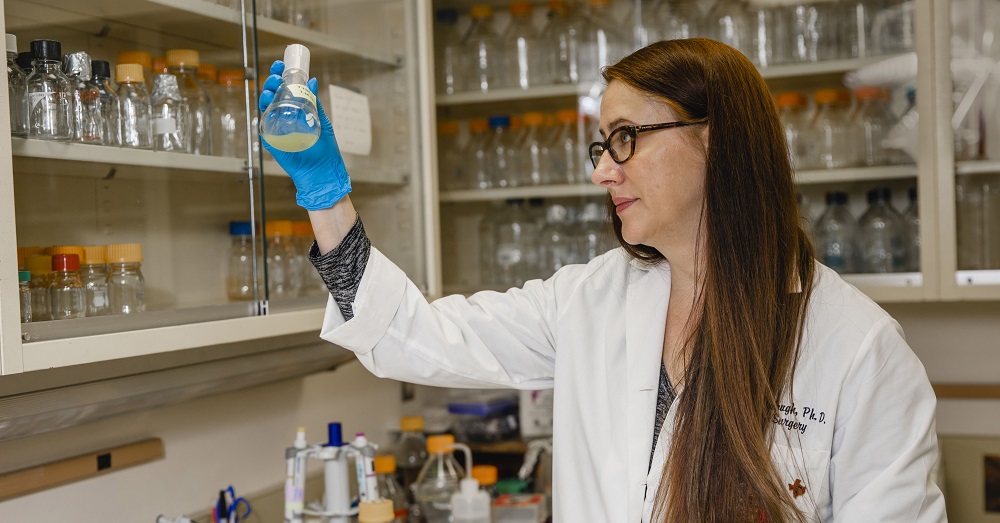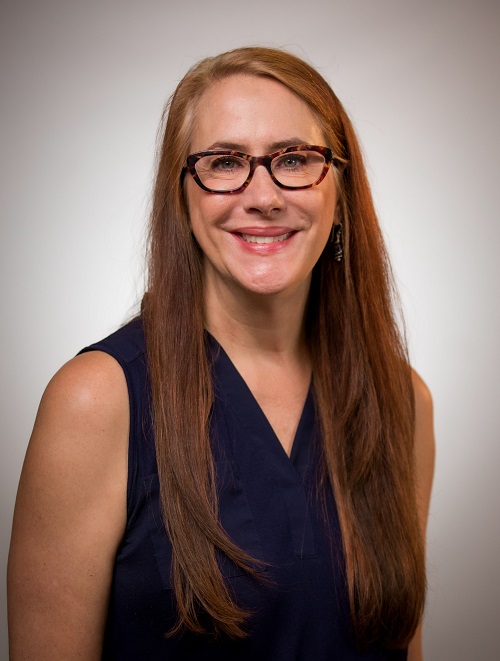
Biofilms, which are composed of an array of microorganisms that congregate as a mass, usually on some type of surface such as a wound bed, are thought to be associated with up to 80% of infections. They also are a focus of research for Kendra Rumbaugh, Ph.D., a professor the School of Medicine’s Department of Surgery at the Texas Tech University Health Sciences Center (TTUHSC).
“Biofilms are a community of microbes such as bacteria, fungi and usually a combination of many different species all living together in this very close-knit community, which is surrounded by a matrix that is very difficult to penetrate,” Rumbaugh explained. “It’s a way that they can essentially protect themselves. They hunker down; I think of it as living in a bunker. When we try to kill them, either with anti-microbials, or when we have an infection and our immune cells are trying to kill them, this bunker that surrounds them makes it really difficult to penetrate and get to them.”
In a 2022 review published in Nature Reviews Microbiology (“Dispersing Biofilm Myths”), Rumbaugh describes how the community of biofilm researchers have pulled together to address biofilm formation and the problems they cause. These researchers include microbiologists, physicians, chemists, physicists and engineers.
“Nature and the Nature portfolio of journals are among the world’s elite scholarly journals and features only the most impactful and cutting-edge research studies in all areas of science and technology,” Lance R. McMahon, Ph.D., TTUHSC senior vice president for research and innovation, said. “This accomplishment by Dr. Rumbaugh illustrates the global impact of our university’s research and the international preeminence of our faculty.”
In her lab, Rumbaugh studies infections and biofilms that occur in wounds. She is using a bacteria known as Pseudomonas aeruginosa (P. aeruginosa) to investigate ways to disperse, or move individual bacteria and other microbes out of the biofilm and then use existing antibiotics to kill them more effectively.
“It’s really hard when they’re in that biofilm state because they’re basically dormant and they’re surrounded by this gunk like they’re in a bunker,” Rumbaugh said. “We want to try to get them out of that bunker, and we know from lots of studies, including our own, that when we do that, when we force them to be planktonic (freely floating), they’re much more susceptible to killing. That’s been the therapeutic goal of our research: trying to find ways to disperse bacteria out of the biofilm and then use what we already have, such as antibiotics, to kill them more effectively.”
There are several approaches Rumbaugh’s laboratory team is studying to accomplish this dispersal. The first is to use certain already-known signals and cues that cause certain bacterial species to leave the biofilm.

“We know that when things like nutrients are low, some bacteria start to leave the biofilm, probably to look for new nutrients,” Rumbaugh said. “So there are certain stress cues, nutrient signals and small molecules that we can use to force them to leave. That’s one approach: trying to put out a signal that fools them into leaving.”
Rumbaugh’s laboratory also has studied the use of enzymes to break down the biofilm matrix, or bunker. Those studies have revealed the composition of the matrix surrounding some of the biofilm’s bacterial species, and demonstrated how the enzymes target and degrade the matrix.
“The enzymes expose the bacteria so they’re not as protected; then we can see them start to leave the biofilm,” Rumbaugh said. “We’ve done quite a bit of work where we’ve done this in mouse infections and we can give those enzymes, break down the biofilm, visualize the bacteria leaving and then kill them more effectively with antibiotics.”
Rumbaugh’s lab is engaged in a robust collaboration with faculty researchers at the Georgia Institute of Technology (Georgia Tech) to study what is called lifestyle changes that determine the impact of P. aeruginosa on a biofilm infection. Rumbaugh said P. aeruginosa is basically a model species for studying biofilm. In fact, it’s one of the most studied bacterial species in the field of biofilm studies and one that her research has focused upon.
The primary reason P. aeruginosa is of interest to investigators is that it causes both acute and chronic infections, depending on different factors present in different people. However, biofilm researchers still don’t understand why P. aeruginosa can be present for an extended period of time and cause a very localized infection that’s not necessarily life threatening to one patient, yet cause a life-threatening sepsis in another patient by getting into the blood and organs.
“P. aeruginosa can do both of these things, and we don’t really understand why it does one sometimes and the other sometimes,” Rumbaugh added. “It’s the same species that can do both, so why is that?”
One of the reasons is that P. aeruginosa is able to change lifestyles. Some live a planktonic lifestyle where they float around freely in search of a new place to settle or some new nutrients. Others live a biofilm lifestyle where the bacteria are more community-settled and almost dormant.
“When these microbes make biofilms, we think that one of the things that happens to them — there are a lot of changes from that planktonic state to a biofilm state, but one of the major things that is believed to happen is they slow down their metabolism and almost become dormant,” Rumbaugh said. “This also is bad for treatments because a lot of our treatments, antibiotics especially, target actively dividing cells. If they’re just stationary and dormant, the therapeutics might not see them as easily.”
In a study with her Georgia Tech collaborators that was published in May by Nature (“A Pseudomonas aeruginosa small RNA regulates chronic and acute infection”) Rumbaugh said they identified a specific gene known as SicX that’s very highly transcribed in human infection and seems to be a pivotal gene in deciding which type of lifestyle P. aeruginosa will follow.
And while her Georgia Tech colleagues are interested in potentially following and translating biomarkers such as SicX, Rumbaugh’s laboratory will continue to focus on trying to therapeutically develop enzymes for topical use on wounds. No matter which proves most effective, Rumbaugh believes the idea of biofilm dispersal with enzymes or using other methods will become a more preferred strategy.
“I think we’ve just tried so many other things with biofilms and they are really hard to tackle,” Rumbaugh stressed. “That’s why I think we’ll see a lot more translation in the biofilm area, a lot more people just trying to fundamentally understand the process of dispersal where you’re trying to force bacteria to disperse in different ways to kill them more effectively.”
